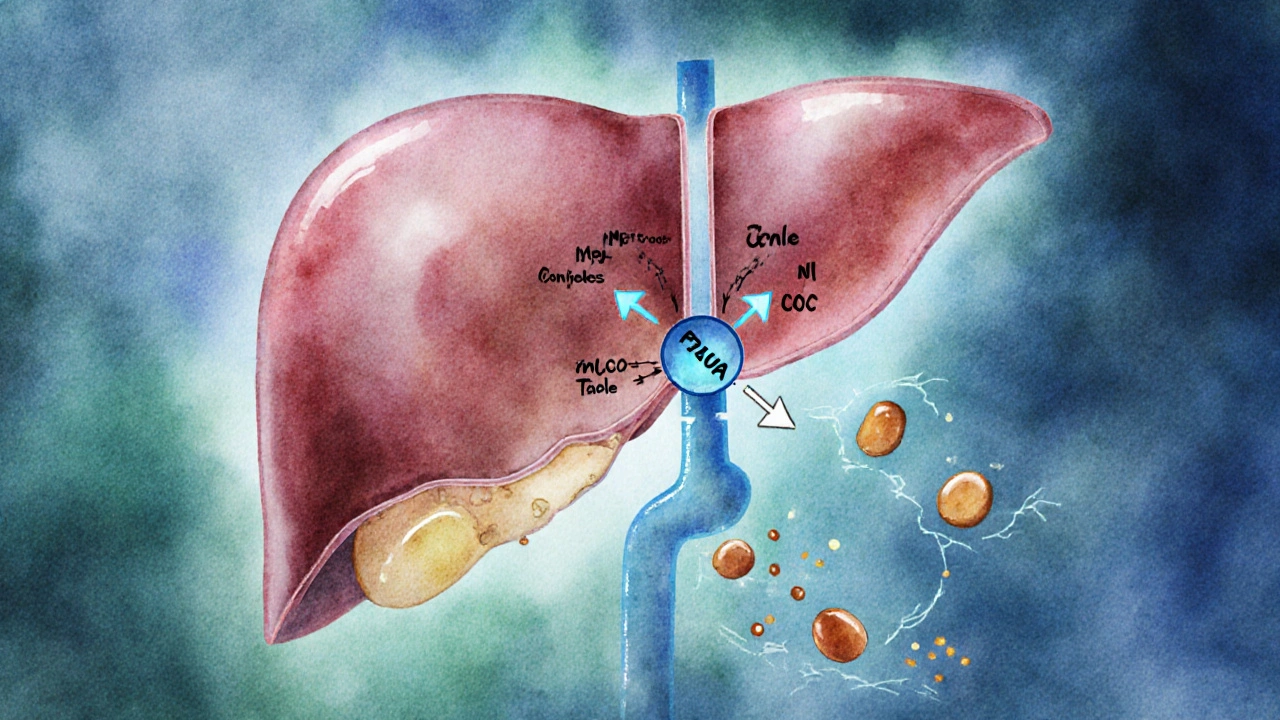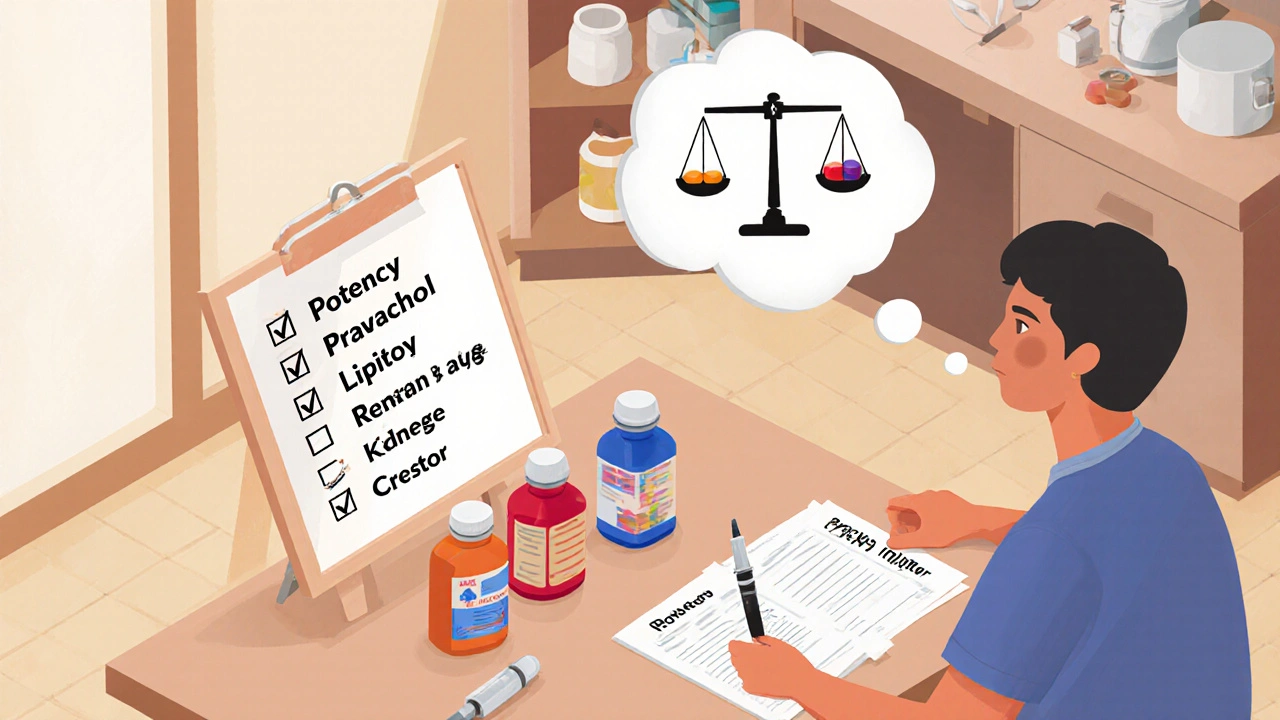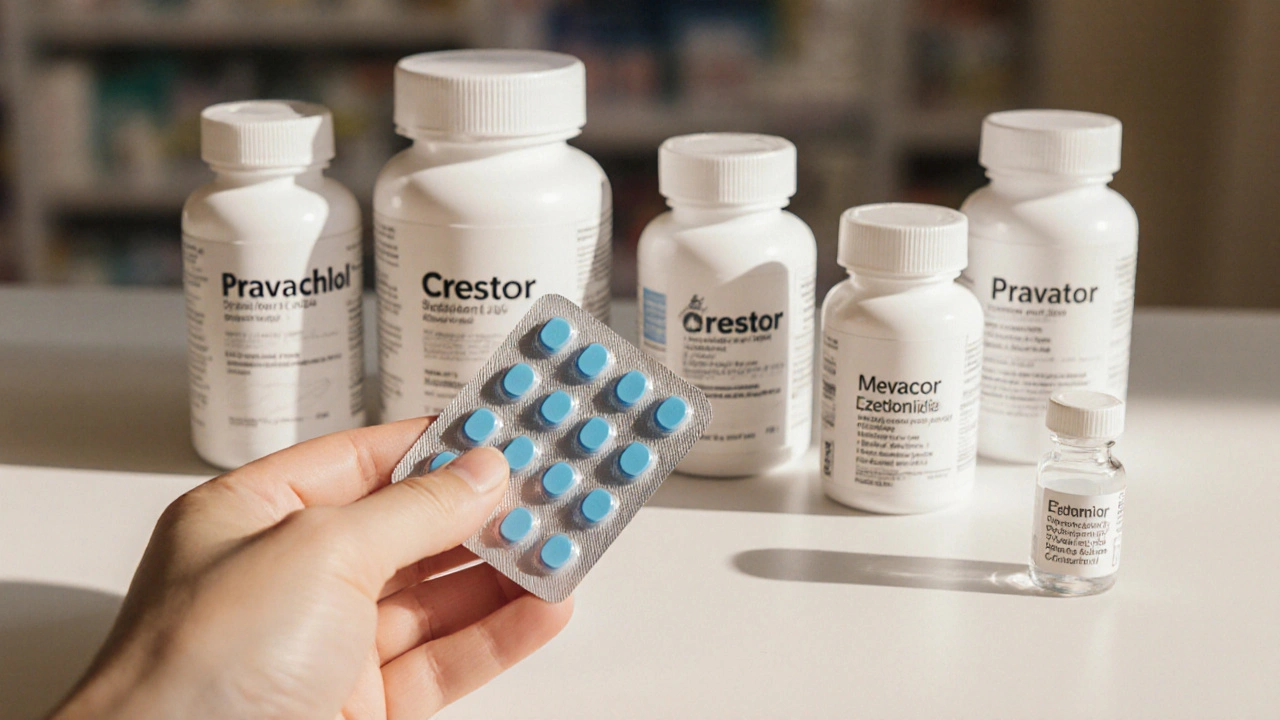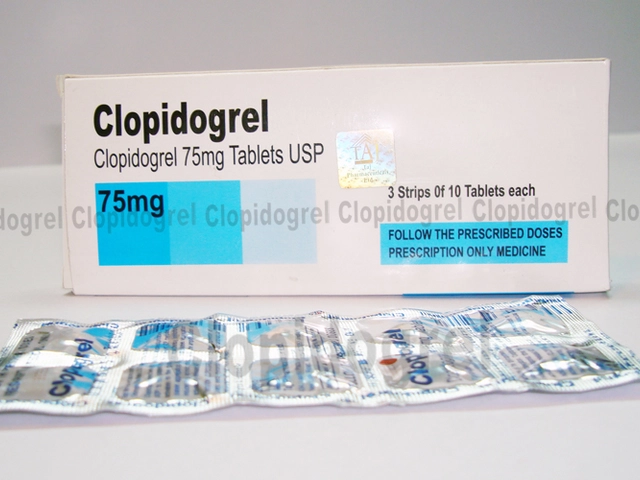Key Takeaways
- Pravachol is a low‑potency, liver‑friendly statin that works well for mild‑to‑moderate LDL reduction.
- Higher‑potency statins like Lipitor and Crestor lower LDL faster but carry a greater risk of muscle‑related side effects.
- Non‑statin options such as ezetimibe or PCSK9‑inhibitor injections are useful when statins are not tolerated.
- Cost, drug interactions, and personal health factors (age, liver function, kidney disease) should drive the final choice.
- Always discuss any switch or addition with your prescriber to avoid dangerous interactions.
When your doctor orders a cholesterol‑lowering pill, the brand name on the prescription can feel like a mystery. Pravachol is a prescription statin (generic name pravastatin) that targets LDL cholesterol by inhibiting the HMG‑CoA reductase enzyme in the liver. But is it the best fit for you, or should you look at a different statin or even a non‑statin option?
This guide breaks down how Pravachol stacks up against the most common alternatives. We'll walk through the science, compare key attributes like potency and side‑effect profile, and give you a decision‑making checklist so you can talk to your doctor with confidence.
How Statins Work - The Basics
All statins share the same core mechanism: they block HMG‑CoA reductase, the enzyme that kick‑starts cholesterol production in the liver. By curbing this pathway, the liver pulls more LDL from the bloodstream, lowering total cholesterol levels. The differences among statins come down to how strongly they block the enzyme (potency), how long they stay active (half‑life), and how they are processed by the body (metabolism).
Pravachol at a Glance
Pravachol is a low‑to‑moderate potency statin approved in 1991. It is typically prescribed at 10‑80mg once daily, with the most common starting dose of 20mg. Because it is water‑soluble, Pravachol has less reliance on the liver’s CYP3A4 pathway, meaning fewer drug‑drug interactions compared with many other statins.
- Typical LDL reduction: 20‑30% at standard doses.
- Half‑life: About 1.8hours, but its active metabolites extend the effect.
- Cost: Generic versions are inexpensive, often under $10 per month in Australia.
- Side‑effect profile: Lower incidence of muscle pain (myalgia) and liver enzyme elevation.
Pravachol shines for patients who need a gentle cholesterol‑lowering approach, especially those on multiple medications that could interact with CYP450 enzymes.
What to Compare When Choosing a Statin
Before we dive into the side‑by‑side table, here are the five criteria most patients consider:
- Potency: How much LDL can the drug lower?
- Safety: Risk of muscle injury, liver enzyme spikes, or cognitive effects.
- Drug interactions: Does the statin use the CYP3A4 pathway?
- Cost and availability: Generic vs brand, insurance coverage, out‑of‑pocket price.
- Special populations: Suitability for seniors, patients with kidney disease, or those on organ transplant meds.

Statin and Non‑Statin Alternatives Compared
| Medication | Generic Name | Typical LDL Reduction | Potency Rank* | Common Dose Range | Key Side‑Effects | Drug‑Interaction Profile | Average Monthly Cost (AU$) |
|---|---|---|---|---|---|---|---|
| Pravachol | Pravastatin | 20-30% | 3 | 10-80mg | Low muscle pain, mild liver changes | Low (minimal CYP3A4) | 8‑10 |
| Lipitor | Atorvastatin | 35-50% | 5 | 10-80mg | Higher myalgia, rare liver spikes | Moderate (CYP3A4) | 12‑15 |
| Crestor | Rosuvastatin | 45-55% | 6 | 5-40mg | Potential for muscle pain, rare kidney issues | Low (minimal CYP2C9) | 15‑20 |
| Zocor | Simvastatin | 30-40% | 4 | 5-40mg | Higher myopathy risk at >20mg, liver enzymes | High (CYP3A4) | 9‑12 |
| Mevacor | Lovastatin | 25-35% | 2 | 10-80mg | Gastro‑intestinal upset, modest muscle pain | High (CYP3A4) | 7‑9 |
| Ezetimibe | Ezetimibe | 15-20% (add‑on) | 1 (non‑statin) | 10mg | Rare muscle pain, mild GI upset | Very low (no CYP interaction) | 25‑30 |
| Alirocumab | Alirocumab | 50-60% (injectable) | 7 (PCSK9‑inhibitor) | 75‑150mg SC q2‑4weeks | Injection site reactions, flu‑like symptoms | Negligible (biologic) | 300‑350 |
*Potency rank is relative within this list, 1 being lowest and 7 highest.
Deep Dive into Each Alternative
Lipitor (Atorvastatin)
Lipitor is the go‑to high‑potency statin for patients who need aggressive LDL reduction, such as those with existing heart disease. It’s metabolized heavily by CYP3A4, so drugs like certain antibiotics, antifungals, or grapefruit juice can raise its levels. The trade‑off is a slightly higher chance of muscle pain, especially at doses above 40mg.
Crestor (Rosuvastatin)
Crestor offers the strongest LDL drop among oral statins while using a different metabolic pathway (mostly CYP2C9). This means fewer interactions with common meds, but patients with kidney impairment need dose adjustments because the drug is cleared renally.
Zocor (Simvastatin)
Simvastatin became famous after the FDA warned against doses above 20mg for patients on certain antibiotics. It’s a solid middle‑ground statin, cheaper than Lipitor or Crestor, but its interaction profile is the most complex due to strong CYP3A4 reliance.
Mevacor (Lovastatin)
Lovastatin is the oldest statin still on the market. It’s often used in combination with diet changes for mild hypercholesterolemia. Like Simvastatin, it depends on CYP3A4, so the same cautions apply. Its side‑effect profile is mild, making it a decent starter for younger patients.
Ezetimibe
Ezetimibe works at a completely different checkpoint: it blocks cholesterol absorption in the intestine. Doctors frequently add it to a low‑dose statin when LDL goals aren’t met. Because it doesn’t need liver metabolism, the drug‑interaction risk is minimal-ideal for patients already juggling many prescriptions.
Alirocumab
Alirocumab is a PCSK9‑inhibitor, a biologic injected every 2-4 weeks. It can slash LDL by up to 60% and is approved for people with familial hypercholesterolemia or those who can’t tolerate statins. The cost is high, and insurance coverage varies, but for high‑risk patients it can be a lifesaver.
Pros and Cons of Pravachol
- Pros:
- Gentle on the liver; low rise in ALT/AST enzymes.
- Minimal CYP3A4 interaction-good for polypharmacy.
- Well‑tolerated in seniors; low incidence of myalgia.
- Generic price keeps out‑of‑pocket expenses low.
- Cons:
- Modest LDL reduction-may not hit aggressive targets.
- Shorter half‑life means strict once‑daily timing for best effect.
- Not ideal for patients with very high baseline cholesterol.

How to Choose the Right Cholesterol Medication for You
Use the following quick decision tree. Answer each question honestly, then match your profile to the best option.
- Do you need a large LDL drop (≥45%)?
- Yes → Consider high‑potency statins (Lipitor, Crestor) or PCSK9‑inhibitors.
- No → Low‑to‑moderate potency statins (Pravachol, Mevacor) may suffice.
- Are you taking medications that heavily use the CYP3A4 pathway (e.g., certain antibiotics, antifungals, calcium‑channel blockers)?
- Yes → Pick a statin with low CYP3A4 involvement (Pravachol, Crestor).
- No → Any statin is an option.
- Do you have a history of muscle pain on statins?
- Yes → Start with a low‑potency statin (Pravachol) or try ezetimibe alone.
- No → You can trial higher doses if needed.
- Is cost a primary concern?
- Yes → Generic Pravachol, Mevacor, or Simvastatin are cheapest.
- No → Consider newer agents despite higher price.
- Do you have kidney disease or are you on dialysis?
- Yes → Avoid Crestor (renally cleared) and PCSK9‑inhibitors unless prescribed.
- No → All options remain on the table.
After you run through the checklist, discuss the shortlist with your cardiologist or GP. They can order blood tests to see how your liver enzymes and creatine kinase respond after the first few weeks.
Next Steps and Troubleshooting
If you start Pravachol and notice any of the following, stop the medication and call your doctor:
- Unexplained muscle weakness or dark urine (possible rhabdomyolysis).
- Persistent nausea, vomiting, or yellowing of the skin/eyes (liver concerns).
- New onset diabetes symptoms-statins can modestly raise blood sugar.
For mild side‑effects, your doctor may simply lower the dose or add a low‑dose ezetimibe to keep cholesterol numbers on track.
Frequently Asked Questions
Can I take Pravachol and a blood thinner together?
Yes, Pravachol does not significantly affect the metabolism of most anticoagulants like warfarin. However, regular INR monitoring is recommended because any medication change can shift clotting times slightly.
What is the best time of day to take Pravachol?
Take it in the evening with food. Cholesterol synthesis in the liver peaks at night, so an evening dose maximizes the drug’s effect.
Is pravastatin safe during pregnancy?
Statins, including pravastatin, are classified as pregnancy category X-meaning they are contraindicated. Women planning a pregnancy should stop the drug under medical guidance.
How long does it take to see cholesterol improvements?
Most patients see a measurable LDL drop within 2‑4 weeks, with the full effect stabilizing by 8‑12 weeks. Repeat lipid panels after three months to assess response.
Can I switch from Lipitor to Pravachol without a wash‑out period?
Generally, yes. Because both are statins, a direct switch is safe, but a physician will usually start you on a lower pravastatin dose and monitor labs after 2 weeks.






Vicki Roth
October 12, 2025 AT 17:55Pravachol seems like the low‑key option for folks wary of drug interactions.
Vishal Bhosale
October 22, 2025 AT 00:19It’s cheap and works ok. Not much else to say.
Garima Gauttam
October 31, 2025 AT 06:43They call it gentle but the real question is whether gentleness ever truly lowers LDL enough to matter.
Georgia Nightingale
November 9, 2025 AT 13:07Honestly, the “gentle” label is just marketing fluff. The data shows a 20‑30 % drop, which for high‑risk patients is borderline. If you need a serious LDL plunge you’ll end up on Lipitor or Crestor anyway, so why settle?
Chris Kivel
November 18, 2025 AT 19:31I’ve been on Pravachol for a year and the only thing I’ve noticed is that I don’t get the usual muscle aches that my brother gets on other statins. It’s also nice that my doctor doesn’t have to tweak a lot of my other meds.
sonia sodano
November 28, 2025 AT 01:55That’s interesting, but “nice” isn’t a medical justification. The modest LDL drop might leave you exposed to cardiovascular events that a stronger statin could prevent.